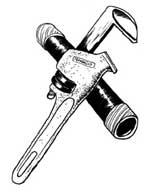Basement and Foundation Repairs
If your home requires foundation repairs it generally means water problems or heat loss. I've experienced both. When my wife and I decided to add a piece on to our home, we took the opportunity to waterproof our original foundation. The house I purchased originally had dirt floor, with a few cement pads holding the water tank, furnace, and posts. We had problems with smell and mold that had to be dealt with quickly. Every rain storm produced a flood of water through the hole in the wall where our drinking water pipes ran through. Several cracks formed in the basement wall from years of neglect and poor cement, and the house was always damp and cold. The foundation repair tips below list some materials you need and a few simple steps to repair foundations against heat loss and water leakage: - Materials required: good drainage gravel, crushed rock, drain tile, landscaping fabric, foam insulation, black tar, driveway sealant, 1" thick basement-grade styrofoam.
- If at all possible, have your yard landscaped in such a way that water flows naturally away from your house on all sides.
- Install good eavestroughing around your eaves.
- If your home is surrounded by clay (ie. no good natural drainage), install drain tile at the bottom of the footing course around your home. This will require hiring an individual with an excavator or backhoe to dig around your home.
- After digging around your home, clean the outside of the basement wall with water to remove mud and debris.
- When placing drain tile around your home, make sure all piping is sloped so the low end of the drain tile is where the water flows out into a ditch. The minimum slope suggested is a 1/8" drop for every foot of pipe.
- Cover drain tile with landscaping fabric to prevent silt and sand from filling the pipes over time.
- When making foundation repairs in the basement wall, fill cracks and/or holes with foam insulation. After the foam dries, cut access foam insulation flush with the wall, and cover the area completely with tar to prevent water seepage into the basement.
- After fixing holes in the foundation (see above), cover the walls with black driveway sealant (or equivalent liquid).
- To prevent heat loss, install at least 1" thick basement-grade styrofoam around the outside of your basement walls.
- If your foundation repairs include digging around your home, you should take the opportunity to refill the void around your home with crushed rock and gravel to facilitate water drainage away from the foundation.
- What about the family? If your kids are old enough, get them to wheel crushed rock and gravel for you. Younger ones can work at keeping you hydrated, wash down walls for you, and act as gophers to get you what you need. Once the walls are washed and patched up, have the older kids apply the sealant on the walls for you.
Generally speaking, foundation repairs take time and require a lot of hard work, but they are also very rewarding. You can literally see, feel, and smell the difference in your home after a successful repair job. Since my wife and I dug around our home and completed all the steps listed above, we haven't had a drop of water leak into our basement. Well, that is until the drain tile froze solid, but that's for another home repair page...
Thanks for the tips on foundation repairs. Take me back home.
|


